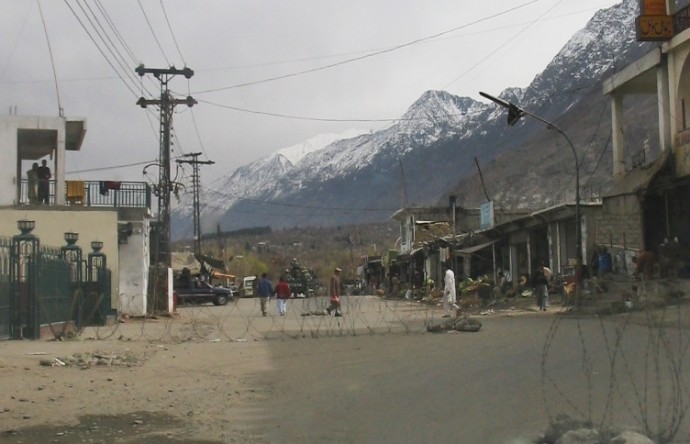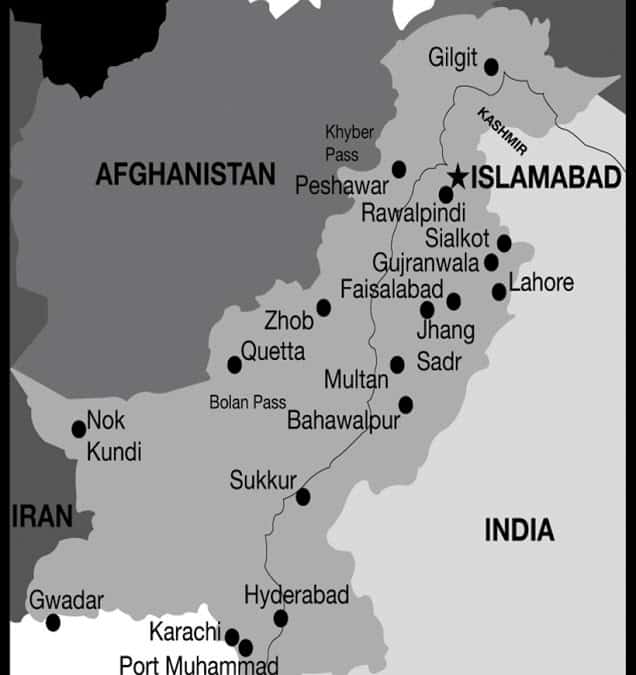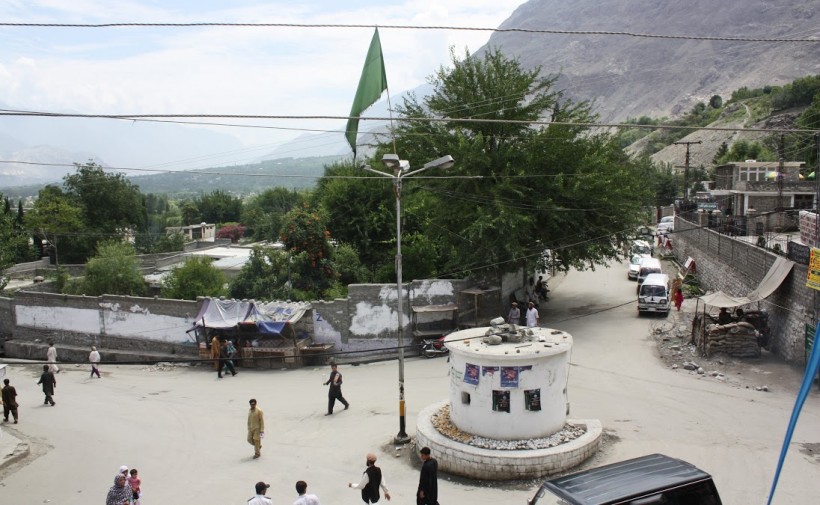Gilgit Town, the administrative capital of the impoverished, neglected and semi-autonomous Gilgit-Baltistan region in northern Pakistan, has been at the heart of nearly 30 years of sectarian conflict in which an estimated 3,000, most Shias and Sunnis, have lost their lives. While the origins of Gilgit’s Shia and Sunni enmities are historical in nature and derive their strength from dynamic variances in sectarian doctrine, interpretation and ritual practice, as well as longstanding ethno-sectarian claims to belonging and power, over recent decades the differences fracturing inter-sectarian sociality have intensified and increased in occurrence and duration. The effect has been that sectarianism, as a simultaneously unifying and conflictive force, now serves to unsettle the myriad commensalities of ethnicity, caste, and kinship which were once valorized ahead of sectarian identity in order to hold each community to the other and keep violence at bay.
Moreover, the dissonances characteristic of Gilgit’s Shia-Sunni ‘tensions’, as the conflicts are locally called, are no longer predicated merely on questions of doctrinal or ethnic difference. They also reflect the acute social distortions and political polarizations arising from Sunnis’ and Shias’ contemporary struggles to capture and seize control of Gilgit-Baltistan’s scarce political and economic capital. Indeed, Gilgit Town’s 80,000 Shia, Sunni and Ismaili Muslim residents are differentiated not only according to the degree of their adherence to sect-specific religiously, socially and politically moderate or conservative positions; they are also ever-more at-odds thanks to the ideologically framed and resource-based competitions inherent to sectarian-aligned projects of regional development, such as the Ismaili Aga Khan Development Network. In turn, Pakistan’s uneven governance of the region, which Martin Sökefeld qualifies as “post-colonial colonialism” (2005), produces power vacuums at local and regional levels, whereby politicization processes and power contestations are conceived along, and draw their freight and impetus most forcefully from, explicitly sectarian rather than shared forms of ethnic or regional affiliation.
With Gilgit Town now principally defined by the discord experienced by Shias and Sunnis and, to a considerably lesser extent, Ismailis (who belong to a sub-sect of the larger ‘Twelver’ Shia sect), my doctoral research (2004-2005) investigated the diverse impacts of inter-sectarian enmity and Shia-Sunni conflict for medical service provision in Gilgit Town’s public, private and non-governmental sector health services (Varley 2008, 2010, 2012).
Against the backdrop of Gilgit’s continuing hostilities, my recent fieldwork has explored how the distribution of health services and Gilgit’s complex and variable moral economy of medical care hinge on questions of sectarian affiliation and identity. By necessary relation, I have also evaluated how the sectarian embeddedness and involvement of clinical sites, health service providers and patients result in exclusionary or differential health service provision and, consequently, a higher observed incidence of maternal morbidity and mortality. Rather than try to fully account for the diverse sectarian modalities associated with medical services and health outcomes in Gilgit Town, this paper provides an ethnographic snapshot of the impacts of conflict on hospital access and service provision, and reflects on the role played by sectarianism in emergent health economies and the redistribution of health resources at the margins of the state (Das and Poole 2004).
Conflict, Sectarianism and Health Disadvantage
My initial interest in the interrelationship between sectarianism, conflict and health services followed from the complex fallouts of Shia-Sunni hostilities for Gilgit’s hospitals after the January 8, 2005 assassination of Gilgit-Baltistan’s Shia religious leader, Zia-u-din Rizvi, by Sunni militants. Gilgiti Shias, who comprise the majority of Gilgit Town’s residents, responded forcefully through the organized use of violence and, by capitalizing on their growing dominance in a wide array of socio-political contexts reduced and excluded Sunnis’ access to and control over political and economic resources, including those related to health. Importantly, Shias’ efforts to estrange Sunnis from resources, and health services in particular, signify the reversal of the discriminatory practices formerly enacted against Shias, a minority in Pakistan but a majority in Gilgit-Baltistan, by Gilgiti Sunnis in coordination with the Sunni-dominated state.
Following Zia-u-din’s death, Gilgit Town was wracked by 10 months of inter-sectarian hostilities, injuries and death, as well as Army curfews, the targeted killings of Sunni community leaders, including physicians, and the logistical disenfranchisement of Sunni patients from Shia mohalla (neighbourhood) based clinical facilities by curfews, checkpoints and the threat of violence.
Because in 2005 Gilgit’s hospitals were based in Shia-dominated areas, and with healthcare services provided largely by Shias and Ismailis, medical sites came tosymbolize Shia advantage and, during active hostilities, Sunni disadvantage. Hospital attendance among Sunni maternity patients, for example, decreased by 90% following the start of the ‘tensions’, which compounded the region’s already high maternal mortality ratio of 500 to 800 deaths per 100,000 live births (Varley 2010). Gilgit’s ‘tensions’ therefore resulted in patients’ marginalization, whether intentional or otherwise, from Shia enclave-based hospitals and, some interlocutors narrated, their neglectful or abusive medical treatment by non-Sunni providers.
In ways which have fuelled Sunnis’ anxieties about hospital settings, on January 8, 2005 the 250-bed government District Headquarters Hospital (DHQ), where Zia-u-din was initially taken for emergency treatment, was the scene for targeted attacks and the killings of nearly 20 Sunnis on and around the site. While gunmen threatened to kill Zia-u-din’s Sunni treating physicians should he die from his injuries, the patient wards throughout the hospital were searched for Sunni male patients and attendants (Varley 2010). Because of the density of Shia homes surrounding the hospital, many Sunni patients and staff were unable to escape the hospital for several days. And even though the Sunni Department of Health Director was shot and killed on January 8 as he attempted to reach the DHQ from his office in the nearby Health Secretariat, in the months that followed Sunni medical officers and paramedical staff were not provided secure transport to and from the hospital, and often refused to attend their duties on days of ‘tension’ (Varley 2010). With physicians targeted for attack because of their perceived importance for the Sunni community, their deaths or relocation from Gilgit to comparatively ‘safer’ urban centers elsewhere in Pakistan, were perceived to prise new spaces for Shia economic and political advancement (Varley 2010: 65).
Sunni women and their families, who figured heavily in health decision-making, routinely stressed the importance of sectarian affiliation in determining their choice of hospital or even Provider.
In order to compensate for their restricted access to the DHQ, for example, Gilgiti Sunnis generated alternative community-funded health facilities. By late January 2005, Sunni politicians and those physicians displaced from their work at the DHQ proposed the ad hoc establishment of the no- and low-cost Kashrote Hospital, known popularly as the ‘Sunni’ Hospital. A government Forestry Officer’s residence in a Sunni mohalla was rented using community donations and converted into a rough Surgery, Labour Room and In-Patient Ward. Because there were no facilities for X-rays, ultrasound and most laboratory tests, many patients were forced to continue relying on the DHQ or costly private clinics. High patient loads of approximately 1,500 patients per month overwhelmed the small hospital site and its staff, most of whom were unpaid volunteers or DHQ employees who received only partial disbursements of their government salaries after joining the Kashrote Hospital. Many staff argued the ‘Sunni’ Hospital was their only safe and viable opportunity for employment in a region increasingly dominated, they felt, by Shia and also Ismaili “control” over hospital administrations and hiring committees. Although a new 30-bed ‘Sunni’ Hospital, the Government City Hospital, was established in 2007 and expanded to a 50-bed facility in 2012, complicated cases are still routinely referred away from the chronically under-equipped hospital to the DHQ.
Nonetheless, many Sunni interlocutors frame their use of the hospital as a point of community loyalty, and emphasize the political and social necessity of prioritizing their allegiance to the at-siege Sunni community ahead of individual health needs.
Sectarian Medical Economies
My 2010 return to northern Pakistan for an additional four years of fieldwork coincided with the renewal of protracted hostilities and bloodshed. In ways which have further compounded the politics and practices of inter-sectarian dissenssion, in the spring and summer of 2012, upwards of 30 Shias, Sunnis and Ismailis were killed in targeted attacks in Gilgit Town, while an estimated 50 Shias and 5 Sunnis were massacred on three separate occasions on the Karakoram Highway and the Naran-Kaghan Route interconnecting Gilgit to Islamabad, Pakistan’s capital. In response, my recent research interrogates how sectarian enmities and recurrent violence shape, amplify and politically differentiate Sunni and Shia forms of identity and belonging, and underpin exclusionary forms of health governance and the post-2005 emergence of sectarian medical economies in particular. In striking ways, Gilgit’s health services now socially and spatially exemplify the institutionalization of sectarian difference.
At the DHQ, Shia religious flags, posters and regular-occurring ritual processions and sectarian-informed political protests signal Shias’ attempts to assert forms of religious, political and territorial dominance over the hospital site and its services.
In ways that the illustrate the interlacing of sectarian and state spaces, a 30 foot high Shia religious flag, emblazoned with the name of Hazrat Ali, the revered fourth Caliph and spiritual progenitor of Shia Islam, was erected overtop the fortified concrete Army bunker which stands at the DHQ’s main entrance. Not coincidentally, this is the same intersection where an estimated 15 Sunnis were killed immediately after Zia-u-din’s January assassination. Sunni physicians and patients remarked that the Army’s apparent inability to remove the flag or, at the very least, to prevent Shia rallies from being held at the hospital site evidence Sunnis’ ongoing logistical vulnerabilities at the DHQ. Nor is it only in-town Sunnis who face challenges accessing the hospital. Because the DHQ is Gilgit-Baltistan’s sole tertiary-care referral hospital, serving a patient base of over 1.5 million residents, Sunni patients from across Gilgit-Baltistan are profoundly affected by thehospital’s insecure spaces.
Gilgitis’ whose access routes to the DHQ fall through ‘enemy’ territory have agitated for the diversion of civil, regional and federal funds in order to construct alternative access routes and ‘Shia’ or ‘Sunni’ health facilities. In the Sunni village of Baseen, which is located at Gilgit Town’s outskirts, a 30-bed government ‘Sunni’ Civil Hospital was inaugurated in 2009, although today it remains incomplete, under-staffed and only partially operable. Speaking in July 2010, a Medical Officer at the Baseen Hospital explained the facility’s importance for local residents quite simply:
“One patient, who needed surgery, refused to go to the DHQ from his home in Baseen, saying ‘I can accept dying a natural death here, but I refuse to accept dying an unnatural death and being killed by a bullet there.’”
In the Shia-dominated village of Danyor, near the site of a Sunni massacre of nearly 200 Shias in 1988, the 2007 establishment of a 30-bed public Civil Hospital (still unfinished), and the 2011 completion of 25-bed hospital funded by a Karachi-based Shia non-government organization, were justified not only through reference to the region’s problematic maternal morbidity and mortality ratios, which persist even despite the near-total medicalization of reproductive and childbirth health, but also the Sunni “terrorists” and mohallas which stand between Danyor’s residents and the DHQ. In turn, the Aga Khan Health Services plans to relocate its in-town hospital, the Gilgit Medical Center, to a “politically neutral” stretch of mountainside between a Sunni and Shia village at Gilgit Town’s outskirts. Notwithstanding Shias’ and Sunnis’ health service vulnerabilities and exclusions, it merits note that Ismailis, who self-position and are understood to be neutral actors and un-invested in (even if also not unaffected by) the conflicts of their Sunni or Shia brethren, enjoy generally unrestricted access to the DHQ and all other Shia and Sunni mohalla-based facilities.
In much the same way that armed ethnic or sectarian conflicts expose identity-related fault lines and precarities in similarly divided cities, such as Belfast and Beirut, Gilgit Town’s Shia-Sunni hostilities demonstrate how identity risks and violence are distributed among and over-represented by some of Pakistan’s most economically, politically and logistically marginalized citizens. To this point, with health facilities acting as sites for the enactment of conflictive sectarianism, providers’ and patients’ experiences crystallize the cultural, moral and political imaginaries by which local hostilities are interpreted and the state assessed. For instance, the DHQ’s numerous insecurities, when considered in conjunction with the risks posed by Gilgit’s newly established, under-staffed and poorly resourced sectarian facilities, serve as analytical and narrative platforms for Gilgitis’ understandings of state dysfunction and governance gaps. Indeed, the regional and national governments’ failure to ensure equitable service provision, improve civil security and reduce hospital-based hazards reinforced my interlocutors’ broader dissatisfactions with the state’s neglects of Gilgit-Baltistan and its peoples; discontents which are shared by and to an ironic degree unify Gilgit’s otherwise at-siege sectarian communities.
Conclusion
In Gilgit, the social segregations and health deprivations observed and imagined to be produced through the differential care provided to patients by their sectarian others, and reinforced by acts of violence on hospital sites, mark sectarianism’s pervasive and often inescapable effects. Moreover, such realities destabilize popular understandings of hospitals as neutral facilities, capable of reducing Shia-Sunni enmity through medical care which is guided by the therapeutic rather than sectarian impulse. In turn, the emergence of sect-specific medical economies, and the unequal and inequitable patterns of illness and death they produce, call our attention to conflict’s enduring impacts for the organization and distribution of healthcare resources, the failure of the state to either enforce civil security or the basic principles of non-discriminatory medical service provision, and the emergence of sectarian identity as a social determinant of health.
The role of sectarianism in health governance raises a number of ethnographic and practical concerns. Under which conditions do health services operate as vehicles of sectarian conflict and, when sectarianism is enacted through medical treatment, mechanisms of vulnerability, exclusion and harm? How do sectarianism’s unwieldy politics affect or undermine medical providers’ ethical commitment to equitable service provision? To what degree, and in which specific ways, can the health sector become a co-participant in the production and exacerbation of sectarian difference?
For deeply divided settings such as Gilgit, can we afford to avoid acknowledgment of the ways that identity can be deployed to privilege one community at the health expense of another?
With sectarianism now inextricably tied to and reified by Gilgit Town’s Shia, Sunni and also Ismaili medical economies, sectarianized hospital sites and services perpetuate sectarian difference, instability and inequality. The sectarian-linked privileging or life-threatening exclusions inherent to Gilgit’s health sector should therefore serve as a necessary cautionary tale, giving us pause as we consider the implications of sectarianism for health programs, policy and interventions in unstable and embattled settings. The story of Gilgit, then, confirms the need for medical ethnographies of deeply divided societies to critically interrogate and illuminate the moral vagaries, distributive ethics and dynamics of identity shaping clinical services and health outcomes during times of crisis and conflict.
References
Das, Veena and Deborah Poole. (2004). Anthropology in the Margins of the State. (Veena Das, Deborah Poole: Editors) Santa Fe, N.M.: School of American Research Press.
Sökefeld, Martin. (2005). “From Colonialism to Postcolonial Colonialism: Changing Modes of Domination in the Northern Areas of Pakistan.” Journal of Asian Studies, 64 (4): 939-973.
Varley, Emma. (2008). “’Halaat Kharab’/Tension Times: The Maternal Health Costs of Gilgit’s Sunni-Shia Conflict” Missing Links in Sustainable Development: South Asian Perspectives. Karachi: SDPI & SAMA Editorial & Publishing Services, pp. 53-80.
(2010).“Targeted doctors, missing patients: Obstetric health services and sectarian conflict in Northern Pakistan.” Social Science & Medicine, 70: 61-70.
(2012). Varley, Emma. (2012). “Islamic Logics, Reproductive Rationalities: Family Planning in Northern Pakistan.” Anthropology & Medicine, 19 (2): 189-206.



 With Gilgit Town now principally defined by the discord experienced by Shias and Sunnis and, to a considerably lesser extent, Ismailis (who belong to a sub-sect of the larger ‘Twelver’ Shia sect), my doctoral research (2004-2005) investigated the diverse impacts of inter-sectarian enmity and Shia-Sunni conflict for medical service provision in Gilgit Town’s public, private and non-governmental sector health services (Varley 2008, 2010, 2012).
With Gilgit Town now principally defined by the discord experienced by Shias and Sunnis and, to a considerably lesser extent, Ismailis (who belong to a sub-sect of the larger ‘Twelver’ Shia sect), my doctoral research (2004-2005) investigated the diverse impacts of inter-sectarian enmity and Shia-Sunni conflict for medical service provision in Gilgit Town’s public, private and non-governmental sector health services (Varley 2008, 2010, 2012).








I couldn’t resist the temptation to congratulate the writer for attempting to decipher the “health economies” of different sects. No doubt, the health system, just like all other “systems”, has been affected worst y fragmentation and sectarian power-play.
However, I would like to mention that the title of this article is a bit misleading. It is based on the “experiences” of people based in a single city and that city may not necessarily be reflective of the trends in all parts of Gilgit-Baltistan. The dynamics in other areas are different, and the worthy researcher knows it very well.
Also, I don’t think the Aga Khan Health Center is being relocated to bring it at some kind of a “neutral” site. The reason that I know pertains to the fact that the current building is not purpose-built and fails to meet the demand for services.
Moreover, it is a gross mistake to say that in 1988 Danyore town was attacked and people were massacred. That unholy war took place in Jalalabad, located almost a hundred kilometers away form Danyore town.
Additionally, it is not entirely correct to use the term “enemy territory” while mentioning routes leading to the DHQ Hospital. This gives the feeling that all the Shias and all the Sunnis consider each other as enemies. Needless to say, this is farthest from the truth. There are very recent examples of how these communities have come together to reclaim their agency for peace, which is systematically being snatched from them by certain state agencies for other “gains”.
Such articles also cement the sectarian divides and carelessly establish myths and fads as the “truth” by shaping them in scholastic manure, if i may dare say. This, definitely, is damaging for the region’s overall wellness.
I can presume that the scholar has tried to remain “focused” and “impartial” and has attempted to hit in all directions.
This leads us to the crucial and historical question of whether a scholar should detach one aspect from the whole social facade and paint it as the ultimate truth, even if unintentionally so.
I thank the commentator for their response to the article and also for sharing their concerns regarding my analysis of the situation in Gilgit-Baltistan, and would like to take the opportunity to respond to several of the points they raised.
I wish to emphasize that at no point does the article profess to address all local or regional issues, peoples or contexts. Indeed, by building on my longitudinal research findings concerning identity-related instabilities and insecurities, I provide an ethnographic evaluation which focuses explicitly on the role played by sectarianism in Gilgit Town’s health service delivery and medical economies.
Yet, through an exploration of the health sector we also gain insights to the broader stresses, uncertainties and polarizations which have come to define – often to a significant degree – inter-sectarian social, economic and political relations in Gilgit Town.
One need only turn to the research precedent, local and regional media, and reports such as those generated by the Human Rights Commission of Pakistan, for example, to confirm how frequently sectarianism continues to shape, or is used to explain, Gilgitis’ experiences with and understandings of sociality, space and governance. Sadly, as my years living in Gilgit and my interlocutors’ narratives attest, routine acts of sectarian violence continue to plague this small city and its peoples. Nor are sectarian-aligned vulnerabilities, enmity or violence exclusive to Gilgit Town, but are observed and reported to occur across Gilgit-Baltistan’s mixed sect communities, albeit in different ways and to variable extents.
With regard to the 1988 massacre, it is worth noting that in addition to Jalalabad, a number of other villages, such as Sakwar, were also the focus for the violence and destruction inflicted by the Sunni lashkar (militia). (For more information on 1988 and more recent conflicts, please see Ali 2008: “Outrageous State, Sectarianized Citizens” and Aase 1999: “The Theological Construction of Conflict: Gilgit, Northern Pakistan”.)
By relation, I wish to respectfully correct the commentator’s suggestion that Jalalabad is “located almost a hundred kilometers away from Danyore town”. Instead, Danyor is no more than 8 or so kilometres from Jalalabad.
Finally, as the commentator aptly notes, there is a critical need to better understand the inter-sectarian resiliency, peace and political activism that endures even despite the worst effects of Gilgit’s multi-generational ‘tensions’. I wholeheartedly encourage other researchers to explore these issues as well as the wide array of equally under-explored, misunderstood or contested aspects of life and governance across Gilgit-Baltistan.
1. While not wishing to make it it a wasteful long debate, and for brevity sack, let me point the worthy scholar’s attention to the title of this article, i.e. “CONFLICT, SECTARIANISM AND HEALTH GOVERNANCE IN GILGIT-BALTISTAN”. It does claim to cover GB, instead of Gilgit city, which is the focus of her attention. The “insights” cannot be uniformly imposed on GB.
2. True that Jalalabad is almost 10 kilometers South of Danyore, but it is not Danyore. Similar for Sakwar, which is located in the limits of Gilgit city, not Danyore.
3. The whole city and the whole region knows that at the core of this so-called sectarian “animosity” is everything except animosity. Save for the revenge killings, which are tribal and medieval in nature, all incidents of violence (which are presented through propaganda tools as sectarian “tension”) are engineered by powerful state institutions, to keep the region destabilized and shrouded in uncertainty. The worthy scholar, however, may not dare to touch the core of the issue, for the fear of losing, most probably, the opportunity to visit the region again.
NOC matters.
I wish to thank the commentator again for their response. As my article and the commentator’s discussion points confirm, there are multiple and oft-times contested perspectives concerning the conflicts in Gilgit-Baltistan.
In responding, I wish to affirm that the experiences and perspectives foregrounded in my article are those of my interlocutors, and not merely mine. While my article’s introduction attempts to broadly trace the complex histories and causes of sectarian enmity, inclusive of state factors, my analysis here prioritizes the explanatory rhetoric employed by those interlocutors who, when discussing conflict and the fracturing of regional health governance, spoke of the contribution of local sectarian forces. My article’s overview of the situation, then, is a product of this ethnographic and analytical choice.